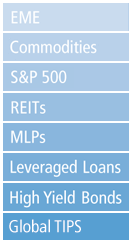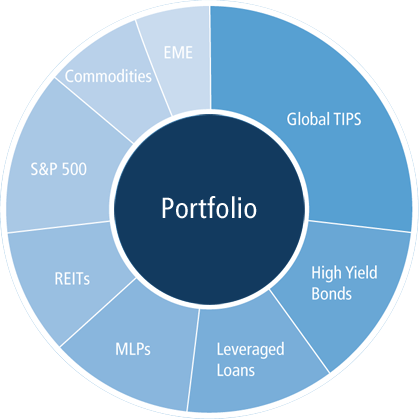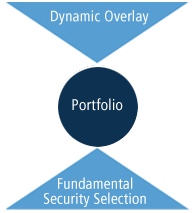Multi-Asset Real Return
A multi-asset class solution that seeks to mitigate inflation and provide real returns in various economic environments
- Portfolio construction utilizing inflation-sensitive asset classes seeking to deliver high correlation to change in expected inflation plus attractive risk-adjusted real returns
- Beta parity framework aims to ensure each asset class has similar contribution to total portfolio inflation sensitivity
- Portfolio sensitivity to inflation expectations is actively "dialed up" or "dialed down" to reflect shorter-term views with a focus on bottom-up security selection

Key Risks
Market Risk: The risk of a change in the value of a position as a result of underlying market factors, including among other things, the overall performance of companies and the market perception of the global economy.
Liquidity Risk: The risk that the portfolio may be unable to sell an investment readily at its fair market value.
Derivatives Risk: The strategy may use certain types of financial derivative instruments (including certain complex instruments). This may increase the portfolio’s leverage significantly which may cause large variations in the value of investments. Investors should note that the strategy may achieve its investment objective by investing principally in Financial Derivative Instruments (FDI). There are certain investment risks that apply in relation to the use of FDI.
Interest Rate Risk: The risk of interest rate movements affecting the value of fixed-rate bonds.
Credit Risk: The risk that bond issuers may fail to meet their interest repayments, or repay debt, resulting in temporary or permanent losses to the portfolio.
Model Risk: The investment strategy of a portfolio using a quantitative investment approach is rules based and model-driven. Therefore, it would not necessarily result in a security being sold because that security’s issuer was in financial trouble or defaulted, or had its credit rating downgraded, unless such indicators are tracked by the investment strategy of that portfolio. There is no guarantee that the investment strategy of such a portfolio will meet the purpose for which it was designed.
Counterparty Risk: The risk that the portfolio may be unable to sell an investment readily at its fair market value.
Operational Risk: The risk of direct or indirect loss resulting from inadequate or failed processes, people and systems including those relating to the safekeeping of assets or from external events.
Currency Risk: Investments in a currency other than the base currency of the portfolio are exposed to currency risk. Fluctuations in exchange rates may affect the return on investment. If the currency of the portfolio is different from your local currency, then you should be aware that due to exchange rate fluctuations the performance may increase or decrease if converted into your local currency.
Overview
Investment Philosophy
Our dynamically managed multi-asset class solution seeks to provide real returns in various inflationary environments and provide downside protection and risk-adjusted real return potential.
Investment Process
- Investments are primarily selected by measuring sensitivity and correlation to changes in long-term inflation expectations
- Utilize dynamic overlay to adjust for inflation sensitivity
- Specialty investment teams seek to add value from active management of each asset class





- Then we strategically allocate across asset classes using a beta parity approach and seek to generate alpha and improve return distribution
- Then we strategically allocate across asset classes using a beta parity approach and seek to generate alpha and improve return distribution
- Finally, we pursue additional alpha via a dynamic overlay and through individual security selection







